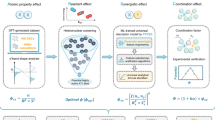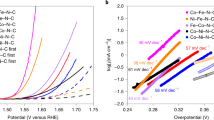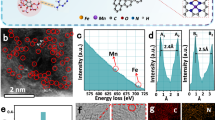Abstract
Dual-atom catalysts, which exhibit high activity and atom utilization, show promise for sustainable energy conversion and storage technologies. However, the rational design and synthesis of a dual-atom catalyst with structurally homogeneous and flexible active sites remains challenging. In this work, we developed a strategy for the synthesis of a carbon-based catalyst with diatomic Fe–Co sites in which the Fe and Co atoms are coordinated to N and O atoms, respectively, and linked through bridging N and O atoms (FeCo–N3O3@C). The Janus FeCo–N3O3@C quaternary dimer is a stable and efficient bifunctional catalyst in the electrocatalytic oxygen reduction reaction (half-wave potential E1/2 = 0.936 V) and oxygen evolution reaction (potential E = 1.528 V at 10 mA cm−2). When assembled in a Zn–air battery, it exhibits superior performance over a benchmark Pt/C + RuO2 air cathode. A series of ex situ and in situ characterizations, combined with theoretical calculations, revealed that the bifunctional performance of the catalyst originates from the strong coupling of the Fe–N3 and Co–O3 moieties, which alters the d-orbital energy level of the metal atoms, optimizing the adsorption–desorption of oxygenated intermediates and improving the reaction kinetics of the oxygen reduction and evolution reactions. The in-depth insights gained into the fundamental mechanism of this dual-atom catalyst at the atomic and electronic level will facilitate the rational design of further highly efficient multifunctional catalysts with customized activities for specific reactions.

This is a preview of subscription content, access via your institution
Access options
Subscribe to this journal
Receive 12 digital issues and online access to articles
118,99 € per year
only 9,92 € per issue
Buy this article
- Purchase on SpringerLink
- Instant access to full article PDF
Prices may be subject to local taxes which are calculated during checkout






Similar content being viewed by others
Data availability
Data supporting the findings of this study are available in the article and Supplementary Information. Source data are provided with this paper.
References
Wang, A., Li, J. & Zhang, T. Heterogeneous single-atom catalysis. Nat. Rev. Chem. 2, 65–81 (2018).
Zhao, J. et al. A heterogeneous iridium single-atom-site catalyst for highly regioselective carbenoid O–H bond insertion. Nat. Catal. 4, 523–531 (2021).
Liang, X., Fu, N., Yao, S., Li, Z. & Li, Y. The progress and outlook of metal single-atom-site catalysis. J. Am. Chem. Soc. 144, 18155–18174 (2022).
Qin, R., Liu, K., Wu, Q. & Zheng, N. Surface coordination chemistry of atomically dispersed metal catalysts. Chem. Rev. 120, 11810–11899 (2020).
Gan, T. & Wang, D. Atomically dispersed materials: ideal catalysts in atomic era. Nano Res. 17, 18–38 (2024).
Zheng, X., Li, B., Wang, Q., Wang, D. & Li, Y. Emerging low-nuclearity supported metal catalysts with atomic level precision for efficient heterogeneous catalysis. Nano Res. 15, 7806–7839 (2022).
Hu, W. et al. Embedding atomic cobalt into graphene lattices to activate room-temperature ferromagnetism. Nat. Commun. 12, 1854 (2021).
Chen, Y. et al. Isolating single and few atoms for enhanced catalysis. Adv. Mater. 34, 2201796 (2022).
Li, R. & Wang, D. Understanding the structure–performance relationship of active sites at atomic scale. Nano Res. 15, 6888–6923 (2022).
Wang, Z. et al. Dual-atomic-site catalysts for molecular oxygen activation in heterogeneous thermo-/electro-catalysis. Angew. Chem. Int. Ed. 62, e202301483 (2023).
Li, R. & Wang, D. Superiority of dual-atom catalysts in electrocatalysis: one step further than single-atom catalysts. Adv. Energy Mater. 12, 2103564 (2022).
Shan, J. et al. Metal-metal interactions in correlated single-atom catalysts. Sci. Adv. 8, eabo0762 (2022).
Liu, C. et al. Catalytic activity enhancement on alcohol dehydrogenation via directing reaction pathways from single- to double-atom catalysis. J. Am. Chem. Soc. 144, 4913–4924 (2022).
Zhang, S. et al. Fe/Cu diatomic catalysts for electrochemical nitrate reduction to ammonia. Nat. Commun. 14, 3634 (2023).
Cui, T. et al. Engineering dual single-atom sites on 2D ultrathin N-doped carbon nanosheets attaining ultra-low-temperature zinc-air battery. Angew. Chem. Int. Ed. 61, e202115219 (2022).
Wu, L., Guo, T. & Li, T. Data-driven high-throughput rational design of double-atom catalysts for oxygen evolution and reduction. Adv. Funct. Mater. 32, 2203439 (2022).
Tang, T., Wang, Z. & Guan, J. Structural optimization of carbon-based diatomic catalysts towards advanced electrocatalysis. Coord. Chem. Rev. 492, 215288 (2023).
Zhang, Y.-X. et al. General synthesis of a diatomic catalyst library via a macrocyclic precursor-mediated approach. J. Am. Chem. Soc. 145, 4819–4827 (2023).
Chen, S. et al. Dehydrogenation of ammonia borane by platinum-nickel dimers: regulation of heteroatom interspace boosts bifunctional synergetic catalysis. Angew. Chem. Int. Ed. 61, e202211919 (2022).
Wang, Z. et al. Atomically dispersed Co2–N6 and Fe–N4 costructures boost oxygen reduction reaction in both alkaline and acidic media. Adv. Mater. 33, 2104718 (2021).
Hao, Q. et al. Nickel dual-atom sites for electrochemical carbon dioxide reduction. Nat. Synth. 1, 719–728 (2022).
Zhao, X. et al. Highly efficient electrochemical CO2 reduction on a precise homonuclear diatomic Fe–Fe catalyst. ACS Catal. 12, 11412–11420 (2022).
Yuan, K. et al. Boosting oxygen reduction of single iron active sites via geometric and electronic engineering: nitrogen and phosphorus dual coordination. J. Am. Chem. Soc. 142, 2404–2412 (2020).
Han, G. et al. Substrate strain tunes operando geometric distortion and oxygen reduction activity of CuN2C2 single-atom sites. Nat. Commun. 12, 6335 (2021).
Yang, J. et al. Compressive strain modulation of single iron sites on helical carbon support boosts electrocatalytic oxygen reduction. Angew. Chem. Int. Ed. 60, 22722–22728 (2021).
Li, J. et al. Metal–organic framework-derived graphene mesh: a robust scaffold for highly exposed Fe–N4 active sites toward an excellent oxygen reduction catalyst in acid media. J. Am. Chem. Soc. 144, 9280–9291 (2022).
Tian, H. et al. High durability of Fe–N–C single-atom catalysts with carbon vacancies toward the oxygen reduction reaction in alkaline media. Adv. Mater. 35, 2210714 (2023).
Li, Y. et al. High-valence nickel single-atom catalysts coordinated to oxygen sites for extraordinarily activating oxygen evolution reaction. Adv. Sci. 7, 1903089 (2020).
Ji, Q. et al. Lattice strain induced by linker scission in metal–organic framework nanosheets for oxygen evolution reaction. ACS Catal. 10, 5691–5697 (2020).
Liu, K. et al. Insights into the activity of single-atom Fe-N-C catalysts for oxygen reduction reaction. Nat. Commun. 13, 2075 (2022).
Pei, Z. et al. Highly efficient electrocatalytic oxygen evolution over atomically dispersed synergistic Ni/Co dual sites. Angew. Chem. Int. Ed. 61, e202207537 (2022).
Zhang, S. et al. Atomically dispersed bimetallic Fe–Co electrocatalysts for green production of ammonia. Nat. Sustain. 6, 169–179 (2023).
Wang, Y. et al. Synergistic Fe−Se atom pairs as bifunctional oxygen electrocatalysts boost low-temperature rechargeable Zn-air battery. Angew. Chem. Int. Ed. 62, e202219191 (2023).
Zhen, X. et al. The effect of proton irradiation on the properties of a graphene oxide paper. RSC Adv. 9, 30519–30525 (2019).
Eissa, M. & El Rouby, W. Effect of alpha particle irradiations on the structural properties of graphene oxide. Int. J. Mod. Phys. B 32, 1850343 (2018).
Hai, X. et al. Scalable two-step annealing method for preparing ultra-high-density single-atom catalyst libraries. Nat. Nanotechnol. 17, 174–181 (2022).
Han, L. et al. A single-atom library for guided monometallic and concentration-complex multimetallic designs. Nat. Mater. 21, 681–688 (2022).
Zhang, X. et al. Identifying and tailoring C–N coupling site for efficient urea synthesis over diatomic Fe–Ni catalyst. Nat. Commun. 13, 5337 (2022).
Zhang, L. et al. Coordination of atomic Co–Pt coupling species at carbon defects as active sites for oxygen reduction reaction. J. Am. Chem. Soc. 140, 10757–10763 (2018).
Tan, H. et al. Engineering a local acid-like environment in alkaline medium for efficient hydrogen evolution reaction. Nat. Commun. 13, 2024 (2022).
Liu, Y. et al. Electrosynthesis of chlorine from seawater-like solution through single-atom catalysts. Nat. Commun. 14, 2475 (2023).
Pei, Z. et al. A polymeric hydrogel electrocatalyst for direct water oxidation. Nat. Commun. 14, 818 (2023).
Günter, T. et al. The SCR of NOx with NH3 examined by novel X-ray emission and X-ray absorption methods. Top. Catal. 59, 866–874 (2016).
Du, Z. et al. Cobalt in nitrogen-doped graphene as single-atom catalyst for high-sulfur content lithium–sulfur batteries. J. Am. Chem. Soc. 141, 3977–3985 (2019).
Chen, C. et al. An asymmetrically coordinated ZnCoFe hetero-trimetallic atom catalyst enhances the electrocatalytic oxygen reaction. Energy Environ. Sci. 17, 2298–2308 (2024).
Kenmoe, S. et al. X-ray absorption near-edge structure (XANES) at the O K-edge of bulk Co3O4: experimental and theoretical studies. Nanomaterials 12, 921 (2022).
Frati, F., Hunault, M. O. J. Y. & de Groot, F. M. F. Oxygen K-edge X-ray absorption spectra. Chem. Rev. 120, 4056–4110 (2020).
Zhang, R., Li, H. & McEwen, J.-S. Chemical sensitivity of valence-to-core X-ray emission spectroscopy due to the ligand and the oxidation state: a computational study on Cu-SSZ-13 with multiple H2O and NH3 adsorption. J. Phys. Chem. C 121, 25759–25767 (2017).
Lancaster, K. M. et al. X-ray emission spectroscopy evidences a central carbon in the nitrogenase iron-molybdenum cofactor. Science 334, 974–977 (2011).
Mortensen, D. R., Seidler, G. T., Ditter, A. S. & Glatzel, P. Benchtop nonresonant X-ray emission spectroscopy: coming soon to laboratories and XAS beamlines near you? J. Phys. Conf. Ser. 712, 012036 (2016).
Li, Z. et al. The marriage of the FeN4 moiety and MXene boosts oxygen reduction catalysis: Fe 3d electron delocalization matters. Adv. Mater. 30, 1803220 (2018).
Xiao, M. et al. 3d-Orbital occupancy regulated Ir-Co atomic pair toward superior bifunctional oxygen electrocatalysis. ACS Catal. 11, 8837–8846 (2021).
Zhang, B. et al. High-valence metals improve oxygen evolution reaction performance by modulating 3d metal oxidation cycle energetics. Nat. Catal. 3, 985–992 (2020).
Sun, K. et al. Co(CN)3 catalysts with well-defined coordination structure for the oxygen reduction reaction. Nat. Catal. 6, 1164–1173 (2023).
Liu, M. et al. Ferredoxin-inspired design of S-synergized Fe–Fe dual-metal center catalysts for enhanced electrocatalytic oxygen reduction reaction. Adv. Mater. 36, 2309231 (2024).
Du, Z. et al. Rapid surface reconstruction of pentlandite by high-spin state iron for efficient oxygen evolution reaction. Angew. Chem. Int. Ed. 63, e202317022 (2024).
Cheng, W. et al. Lattice-strained metal–organic-framework arrays for bifunctional oxygen electrocatalysis. Nat. Energy 4, 115–122 (2019).
Ji, Q. et al. Operando identification of active species and intermediates on sulfide interfaced by Fe3O4 for ultrastable alkaline oxygen evolution at large current density. ACS Catal. 12, 4318–4326 (2022).
Chen, Z. et al. Unraveling the origin of sulfur-doped Fe-N-C single-atom catalyst for enhanced oxygen reduction activity: effect of iron spin-state tuning. Angew. Chem. Int. Ed. 60, 25404–25410 (2021).
Jiang, M. et al. Rationalization on high-loading iron and cobalt dual metal single atoms and mechanistic insight into the oxygen reduction reaction. Nano Energy 93, 106793 (2022).
Tong, M. et al. Operando cooperated catalytic mechanism of atomically dispersed Cu−N4 and Zn−N4 for promoting oxygen reduction reaction. Angew. Chem. Int. Ed. 60, 14005–14012 (2021).
Kresse, G. & Hafner, J. Ab initio molecular dynamics for liquid metals. Phys. Rev. B 47, 558–561 (1993).
Perdew, J. P., Burke, K. & Ernzerhof, M. Perdew, Burke, and Ernzerhof reply. Phys. Rev. Lett. 80, 891 (1998).
Perdew, J. P., Burke, K. & Ernzerhof, M. Generalized gradient approximation made simple. Phys. Rev. Lett. 77, 3865–3868 (1996).
Grimme, S. Semiempirical GGA-type density functional constructed with a long-range dispersion correction. J. Comput. Chem. 27, 1787–1799 (2006).
Acknowledgements
This work was financially supported by the National Key Research and Development Program of China (grant nos. 2023YFF0716100 and 2021YFA1600800 to W.Y.), the National Natural Science Foundation of China (grant nos. 12275271 to C.W., 12305364 to Q.J., 22102167 to Y.Z. and 22325101 to D.W.), the Collaborative Innovation Program of Hefei Science Center, CAS (grant no. 2022HSC-CIP028 to H.T.), the Users with Excellence Program of Hefei Science Center, CAS (grant nos. 2020HSC-CIP013 to W.Y. and 2021HSC-UE002 to C.W.), the Key Program of Research and Development of Hefei Science Center, CAS (grant no. 2021HSC-KPRD002 to W.Y.), the Fundamental Research Funds for the Central Universities (grant no. WK 2310000103 to C.W.) and partially carried out at the USTC Center for Micro and Nanoscale Research and Fabrication and the USTC Instruments Center for Physical Science. The calculations were performed at the USTC Supercomputing Center and Ningbo Artificial Intelligence and High Performance Computing Center. We thank the BSRF, SSRF and beamlines MCD-A and MCD-B (Soochow Beamline for Energy Materials) at the NSRL for synchrotron beamtime.
Author information
Authors and Affiliations
Contributions
H.T., B.M.W., D.W. and W.Y. conceived and designed the project. H.T., D.W. and W.Y. analysed the results. H.T. and B.T. wrote the paper. B.T. and Q.J. performed the synthesis, characterization and electrochemical measurements. Y.Z. performed the DFT calculations. C.W. contributed to the XANES simulations. B.M. and F.S. performed the XES measurements. L.Z. and H.H. performed the zinc–air battery measurements. H.W. carried out the SEM and TEM characterizations. Z.Z., S.Y. and Q.J. performed the XAFS measurements. All of the authors discussed the results and reviewed the paper.
Corresponding authors
Ethics declarations
Competing interests
The authors declare no competing interests.
Peer review
Peer review information
Nature Synthesis thanks Gengtao Fu, Jinwoo Lee and the other, anonymous, reviewer(s) for their contribution to the peer review of this work. Primary Handling Editor: Alexandra Groves, in collaboration with the Nature Synthesis team.
Additional information
Publisher’s note Springer Nature remains neutral with regard to jurisdictional claims in published maps and institutional affiliations.
Supplementary information
Supplementary Information
Supplementary Figs. 1–42 and Tables 1–7.
Supplementary data 1
Statistical source data for the figures in the Supplementary Information.
Source data
Source Data Fig. 2
Source data for FT-EXAFS spectra and the corresponding fitting curves.
Source Data Fig. 3
Source data for XANES and XES spectra and XANES calculations.
Source Data Fig. 4
Source data for electrochemical ORR and OER performance.
Source Data Fig. 5
Source data for DFT calculations, in situ SR-FTIR spectra and in situ XANES spectra.
Source Data Fig. 6
Source data for Zn−air battery performance.
Rights and permissions
Springer Nature or its licensor (e.g. a society or other partner) holds exclusive rights to this article under a publishing agreement with the author(s) or other rightsholder(s); author self-archiving of the accepted manuscript version of this article is solely governed by the terms of such publishing agreement and applicable law.
About this article
Cite this article
Tang, B., Zhou, Y., Ji, Q. et al. A Janus dual-atom catalyst for electrocatalytic oxygen reduction and evolution. Nat. Synth 3, 878–890 (2024). https://doi.org/10.1038/s44160-024-00545-1
Received:
Accepted:
Published:
Issue Date:
DOI: https://doi.org/10.1038/s44160-024-00545-1
This article is cited by
-
Expanding the frontiers of electrocatalysis: advanced theoretical methods for water splitting
Nano Convergence (2025)
-
The geometric-electronic coupled design of diatomic catalyst towards oxygen reduction reaction
Nature Communications (2025)
-
Subnanometric MoOx clusters limit overoxidation during photocatalytic CH4 conversion to oxygenates over TiO2
Nature Communications (2025)
-
Atomic-scale Observation of the Generation and Dispersion of Iron Single Atoms
Chemical Research in Chinese Universities (2025)
-
Biomass-templated strategy to synthesize Fe2P/Co2P heterojunction bifunctional electrocatalyst for high performance flexible zinc-air batteries
Science China Chemistry (2025)



